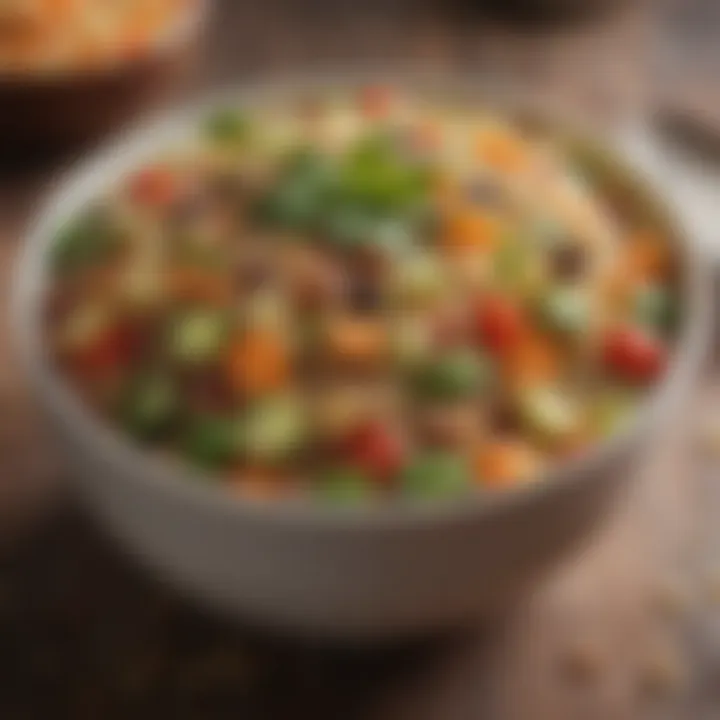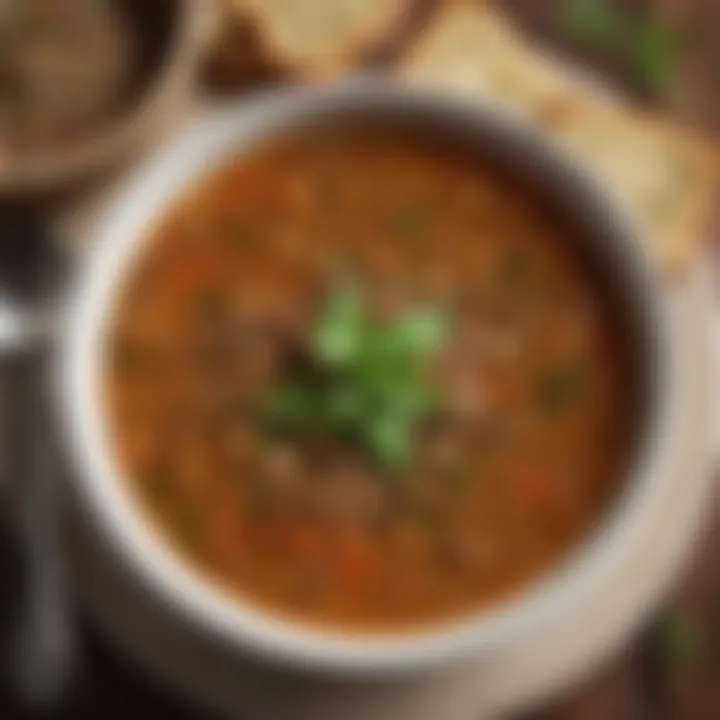High Fiber Vegetarian Meal Plan for Busy Lifestyles


Intro
Recipe Highlight
Chickpea and Quinoa Salad
Packed with protein and fiber, this nutritious meal fits perfectly into any busy lifestyle.
Essential Ingredients:
- 1 cup cooked quinoa
- 1 can of chickpeas, drained and rinsed
- 1 bell pepper, diced
- 1 cucumber, diced
- Fresh parsley, chopped
- Juice of 1 lemon
- 2 tablespoons of olive oil
Estimated Preparation Time: 20 minutes
Servings: 4
Step-by-Step Instructions
- In a large bowl, combine the cooked quinoa and chickpeas.
- Add the diced bell pepper, cucumber, and parsley.
- In a small bowl, whisk together the lemon juice, olive oil, salt, and pepper.
- Pour the dressing over the salad and toss everything together.
- Adjust seasoning to taste before serving.
For best results, use freshly squeezed lemon juice. Also, avoid overcooking the quinoa to keep it fluffy and light.
Variations and Substitutions
Feel free to switch ingredients based on what you have on hand. Consider using black beans instead of chickpeas or adding avocado for creaminess. Extra spices like cumin can enhance flavor as well.
Pair this salad with a side of whole grain bread or a small bowl of soup for a complete meal.
Time-Saving Cooking Tips
To expedite the process, prepare quinoa in advance and store it in the fridge. Try using a food processor to dice the vegetables quickly. If you are planning several meals, consider making a batch of this salad to enjoy through the week.
Nutritional Information
Each serving contains approximately 270 calories, with 15 grams of protein and 12 grams of fiber, promoting healthy digestion and sustained energy. This dish is suitable for vegan and gluten-free diets.
Incorporating high fiber meals significantly benefits gut health and may aid in reducing the risk of chronic diseases.
This narrative simplifies the journey toward healthier eating, making it easier for food enthusiasts to embrace a high fiber vegetarian diet.
Understanding Dietary Fiber
Dietary fiber plays a vital lirole in our health, especially within a vegetarian meal plan. Understanding its components, types, and benefits allows individuals to make informed food choices that enhance their overall wellbeing. Those seeking to incorporate fiber into their diet will find it essential to understand these various aspects, and how they can compare with a vegetarian lifestyle.
Definition of Dietary Fiber
Dietary fiber refers to the parts of plant foods that the body cannot digest or absorb. Unlike other food components like fats, proteins, or carbohydrates, fiber passes through the digestive system nearly intact. It primarily originates from fruits, vegetables, grains, and legumes. There are two main classifications of dietary fiber: soluble and insoluble fiber, each beneficial in its own way.
Types of Fiber
Soluable Fiber
Soluble fiber dissolves in water to form a gel-like substance. This type of fiber greatly helps in lowering cholesterol levels and controlling blood sugar levels. Key sources include oats, beans, apples, and citrus fruits. One defining trait of soluble fiber is its ability to form this gel, which can slow down digestion and moderate the rate of substance absorption. As a beneficial choice, soluble fiber contributes to heart health and aids in feelings of fullness, aiding those looking to manage their weight.
Insoluble Fiber
Health Benefits of High Fiber Intake
Digestive Health
High fiber intake significantly boosts digestive health. It works by promoting regular bowel movements, thus minimizing issues like constipation and diverticulitis. The specific characteristic of fiber to retain water ensures that stools remain soft and easier to pass. An advantage is that a fiber-rich diet not only benefits the gut but may also decrease the risk of certain types of cancer, specifically colorectal cancer.
Weight Management
Incorporating high fiber foods in a vegetarian meal plan can aid weight management. Fiber lengthens the sense of fullness between meals which helps prevent overeating. Another positive feature is that many fiber-filled foods are generally lower in calories, thus benefiting those trying to manage their weight without feeling constantly hungry. Therefore, the inclusion of high fiber foods in meals provides both satisfaction and control over caloric intake.
Blood Sugar Control
High fiber fabrics also support blood sugar control. Dietary fiber slows the absorption of sugar, which helps prevent spikes in blood sugar levels. This effect is especially important for individuals with diabetes or insulin resistance. The inclusion of legumes, fruits, and whole grains within a vegetarian meal can significantly aid in sustaining steady energy levels throughout the day.
Remember: High fiber foods can help prevent health complications related to digestion, weight management, and blood sugar control. Incorporating these elements into a meal plan is essential for those striving for a balance between health and dietary enjoyment.
Principles of a Vegetarian Diet
Core Components of Vegetarianism
Vegetarianism is based on the consumption of plant-derived foods, with optional animal products depending on the specific type of vegetarian. Types like lacto-vegetarian, pesco-vegetarian, and ovo-vegetarian each have unique distinctions, which can manifest in varied nutritional profiles.
The core components typically include:
- Fruits and Vegetables: Vital sources of vitamins, minerals, fibers, and delightful flavors.
- Legumes and Nuts: Excellent proteins that provide satiation and enhance fiber intake.
- Whole Grains: Rich in nutrients and overall better for digestive health when whole grains are chosen rather than refined.
Understanding these components helps to form the foundation of a high fiber vegetarian diet, ultimately leading to improved health outcomes.
Nutritional Considerations
Focusing on nutrition within a vegetarian diet ensures that needed elements for one’s health are not overlooked. There are two aspects importantly associated with nutritional considerations: Essential Nutrients and Protein Sources.


Essential Nutrients
Essential nutrients are those that the body cannot produce independently and need to be supplied by food. They are important for physiological functions and overall health. While a vegetarian diet provides a broad spectrum of vitamins and minerals, several essential nutrients require attention:
- Vitamin B12: Crucial for nerve function and making DNA. It is mainly found in animal products, so diligence is needed for those on strict vegetarian diets.
- Iron: Found in plant-based sources like spinach and– lentils; absorption efficiency is lower, necessitating regular consumption to meet needs.
- Calcium: It's important for bone structure; alternatives such as fortified non-dairy milk may be used.
These nutrients are of great importance here since they play a vital role in sustaining a balanced diet without unnecessary complications.
Protein Sources
Protein is essential for muscle repair, immune function, and making enzymes. Vegetarians often obtain protein from a wide range of sources, ensuring that a varied diet is both satisfying and nutritious:
- Legumes: Lentils, beans, and peas add essential protein and fiber to meals.
- Nuts and Seeds: Providing protein, healthy fats, and fiber; recommendations include almonds, chia seeds, and hemp seeds.
- Whole Grains: Addressable options such as quinoa or farro contribute protein uniquely combined with fiber content.
Selecting protein sources from plants allows for a versatile meal preparation experience, which is not only nutritious but enticing. Incorporating diverse ingredients saves interest in extensive meal prep without monotony.
In summary, Principles of a Vegetarian Diet guide individuals through essential choices, enabling the realization of a systematically health-conscious approach, focusing on abundant fiber, diverse proteins, and necessary nutrients.
Daily Fiber Recommendations
The daily fiber intake recommendation varies with age, sex, and individual health issues. Generally, adults should aim for about 25-38 grams of fiber per day. Women typically aim for 25 grams, while men should aim for 38 grams. It’s vital to consider drinks and overall hydration as well when upping fiber intake. More on fiber sources can help enhance understanding as well.
Sample Meal Framework
This section outlines how to integrate high fiber into meals throughout the day. This daily structure helps adhere to nutritional goals while meeting personal taste preferences.
Breakfast Options
Breakfast is often considered the most crucial meal of the day, however, finding high fiber choices might be tricky. \Many whole grain cereals and oats contain substantial fiber, promoting satiety. Adding fruits can elevate fiber levels significantly. Yet, people need to ensure any choices are not heavily processed for greater benefits. Noting the fiber impact on fullness helps tremendously with energy levels throughout the morning.
Lunch Ideas
For lunch, salads with beans and legumes stand out because they are rich in both fiber and protein. The combination of greens, vegetables, and pulses ensures a complete nutrient absorption. Consider whole grain wraps filled with colorful fillings as creating a visually pleasing and amply nutritious lunch. It aids the ease in preparations without compromising enjoyable meals at midday. Breathing creativity in what one eats takes lunch from simple to remarkable.
Dinner Suggestions
Dinner tends to be a family meal where preparation can sometimes feel daunting, yet that isn't the case. Introduction of stir-fries packed with a variety of veggies can quickly build a meal high in nutrients. Grain bowls also provide flexibility as a foundational element. Introducing unique toppings can bring notable temperatures and taste alive your plate. Making meals composed, colorful, and satisfying leads towards better health too.
Snacks and Desserts
For snacks and desserts, thinking beyond chips or cookies opens up many high fiber options. Sliced fruits with nuts allows enjoying sweetness naturally, while frozen treats made from pureed fruits can satisfy cravings effectively. Meaningful portion choices will safeguard energy balance throughout the day and create sustainable eating habits. Less processed options prevail favorably leading into snacking tendencies in daily practices.
Increasing fiber intake gradually is essential. Too much fiber at once can lead to digestive issues.
The meal framework creates foundations, guiding individuals towards numerous possibilities leading healthy nutritious eating habits while sourcing both outer and inner satisfaction, empowering daily expenditures.
Breakfast: High Fiber Choices
Breakfast is an essential meal that can significantly influence the rest of your day. Starting with high fiber options promotes better digestion, can assist in weight management, and provides lasting energy needed to tackle your morning tasks. A high fiber breakfast keeps you satiated, helping to curb mid-morning cravings, which is beneficial in a balanced vegetarian meal plan.
Whole Grain Cereals
Whole grain cereals are an excellent choice for breakfast due to their high fiber content. They are often rich in both soluble and insoluble fiber, which contribute to excellent digestive health. Look for cereals that list whole grains as the first ingredient. Examples might include oats, bran flakes, or shredded wheat. These cereals provide vital nutrients as well, including B vitamins, iron, and magnesium.
A serving of whole grain cereal can help fulfill part of the daily fiber recommendations. Eating them with plant-based milk instead of whole dairy milk increases the meal's fibers. Combined, they form a sustaining breakfast that helps equip one for a productive day ahead.
Smoothies and Bowls
Smoothies and bowls present a flexible and enjoyable breakfast option, rich in fiber. They allow creativity in ingredient choice, enabling one to easily include various fruits, vegetables, and seeds.
Additions for Fiber Boost
Integrating additional ingredients is a vital aspect of crafting smoothies and bowls ideal for increased fiber content. Choices like chia seeds, flaxseeds, or even avocados can significantly increase the fiber profile of the meal. Additionally, leafy greens like spinach or kale add volume without excessive calories, increasing satisfaction.
The key characteristic of these additions is their versatility and ease of incorporation into various recipes. By blending in these fiber sources, the smoothie or bowl becomes gut-friendly and supports sustained energy release throughout the morning. One prominent advantage is the potential ease of digestion these ingredients can provide, especially when consumed blended, which assists some with fiber intake.
Preparation Tips
Preparation of smoothies and bowls can enhance their nutritious qualities. For example, prepping ingredients the night before saves time. Simply mix fruits or vegetables in a container. If going for a smoothie, process fruits and vegetables when you wake up.
An important feature of these preparation tips is the potential to batch-prep. By using ingredients that won't spoil quickly—like certain frozen fruits or oats—one can create numerous meals in advance for a busy week ahead. This not only eliminates time spent, but it also aids in maintaining consistent fiber intake days to come. Ultimately, preparation is simplified, making it a manageable solution for those navigating busy mornings.
Integrating high-fiber options into breakfast provides not just immediate satiety but lasting benefits that support overall health goals.
Lunch: Fiber-Packed Options
Lunch is a crucial meal in a high fiber vegetarian diet. It serves as a bridge between breakfast and dinner. This meal can be the heart of your eating routine, providing essential nutrients and a energy needed for the remainder of the day. Healthful options can improve focus and keep you feeling full. Fiber-packed lunches can help regulate digestion and contribute to overall well-being.
Salads with Beans and Legumes
Salads feature prominently in fiber-rich diets. Including beans and legumes increases the fiber content considerably. These ingredients come with variety of nutrients and essential minerals. Popular options include black beans, kidney beans, chickpeas, and lentils. Each serves as not just a fiber source but also adds protein. This keeps the intestinal tract healthy while keeping hunger at bay.


Whole Grain Wraps
Whole grain wraps represent a fantastic way to enjoy bulk of dietary fiber. They offer endless options for fillings while being easy to find and prepare. They are combined with fiber-rich vegetables, beans, and sauces, making meals interesting and varied.
Filling Ideas
Thinking creatively about fillings is important. Consider things like roasted vegetables, quinoa, or hummus. Each one contributes a significant amount of fiber. These fillings allow variation and help satisfy different tastes.
- Roasted Vegetables serve as a great option.
- Quinoa provides not only fiber but also protein.
- Hummus adds creaminess and further fiber, crucial for a healthy wrap.
Using creative filling combinations the meals should never be dull. Quite easy to interchange ingredients for new tastes. Everyone loves filling flavors and colors in their food, making wraps popular.
Easy Preparations
One of the significant advantages of wraps is how easy they are to put together. Time constraints often limit cooking interest. Making a wrap helps focus on nutrition while being simple enough. It is usually just chopping and layering ingredients together before rolling.
- Quick preparation helps timers in hectic days.
- Minimal cooking ensures more nutrient retention.
Taste tends to be fresh and engaging. Treat a wrap as canvas to paint flavors accross. Its unique combining versatility allows it to be a meal fitting into many dietary preferences while promoting meal satisfaction.
Built around high fiber demands, creative lunchtime meals can energize, nourish, and uplift spirit.
Dinner: Balanced Meals
Dinner is a critical meal for individuals and families eager to maintain dietary balance while incorporating high-fiber vegetarian options. Dinner not only satisfies hunger after a long day, but it also serves as an opportunity to fuel the body with essential nutrients essential to overall health. A well-planned dinner within a vegetarian meal plan can maximize fiber intake while delivering a variety of tastes, textures, and nutrients. Therefore, it is important to focus on efficiency, variety, and nutritional content as we construct our plate.
Vegetable Stir-Fries
Vegetable stir-fries are a cornerstone of any high fiber vegetarian dinner. They are not only quick to prepare but also allow a wide array of vegetables to be used, resulting in increased fiber intake and vibrant flavors. This method of cooking is beneficial as it uses minimal oil and emphasizes fresh ingredients.
Key characteristics of stir-fries include the ability to customize based on seasonal vegetables or personal preference. By varying the kinds of vegetables used, one can enjoy different textures while maximizing fiber richness. Moreover, stir-frying retains the nutrients of vegetables well, providing not just fiber but also vitamins and minerals important for health.
Grain Bowls
Grain bowls present another appealing component of a balanced vegetarian dinner. They are simple to assemble and offer endless combinations of grain, protein, and vegetables. Incorporating various ingredients makes grain bowls a practical choice for individuals seeking high fiber meals.
Base Options
When considering base options, whole grains such as quinoa, brown rice, or farro add substantial fiber content. These grains serve as a solid foundation upon which to build a nutritious meal. Their chewy texture also enhances the overall dining experience. A primary advantage of selecting whole grains is that they provide slow-releasing carbohydrates, further helping with blood sugar control.
Yet, one must be cautious about portions. Overdoing serving sizes can shift the balance in favor of carbohydrates rather than fiber-rich vegetables. Selecting the right grain also aids in the optimal functioning of the meal overall.
Toppings for Nutrients
Toppings elevate the nutritional profile of grain bowls. Incorporating options like beans, lentils, seeds, and nuts delivers extra fiber as well as protein and healthy fats. With a variety of toppings, the possibilities are limitless, ensuring each grain bowl can feel completely different. For instance, adding some chickpeas or roasted nuts can enhance both the texture and nutrient make-up of the meal.
The unique feature of toppings lies in their ability to be modified based on dietary preferences. This versatility ensures the meal fits various nutritional needs while yielding significant health benefits. Some toppings do, however, become calorie-dense rather quickly, thus moderation is key.
In summary, investing time in planning fiber-rich dinners with elements like vegetable stir-fries and grain bowls fosters well-being. They serve not only to nourish but also to create satisfying, varied dining experiences that beautifully support health goals.
Snacks and Desserts
Snacks and desserts play a pivotal role in the overall framework of any meal plan. Not only do they provide instances of indulgence, but they also offer opportunities to integrate more fiber into the diet. High fiber snacks and dessert choices serve several vital functions. They keep the momentum of healthy eating going, provide sustained energy between meals, and reduce unhealthy cravings. Therefore, thoughtfully selected snacks and desserts can significantly enhance the vegetarian diet's nutritional profile.
High Fiber Snack Ideas
When preparing high fiber snacks, intuition should guide ingredient choice. Whole foods such as fruits, vegetables, nuts, and seeds stand out due to their fiber content and beneficial nutrients. Here are some ideas to get started:
- Chickpea Salad: Toss canned chickpeas with cucumber, tomato, and a simple vinaigrette. It is compact with fiber and is easily feasible.
- Veggie Sticks with Hummus: Carrot, celery, and bell pepper sticks dipped in hummus offer not only fiber but also a delicious way to replace chips or unhealthy dips.
- Apple Slices with Nut Butter: Spice up sliced apples with a layer of almond or peanut butter for added protein and fiber.
- Greek Yogurt with Berries: A mix of high-fiber fruits like raspberries with plain Greek yogurt can satisfy both the sweet tooth and the nutritional requirement for fiber.
Each of these snack ideas emphasizes fiber-rich components, helping maintain digestive health while making it easy to keep hunger at bay.
Healthy Dessert Alternatives
Diving into the realm of desserts does not necessitate excess sugar or compromise on health. Instead, approach this category with a focus on high fiber options that still epitomize indulgence. Here are two notable dessert alternatives you can easily integrate into meals.
Fruits and Nut Combinations
Fruits improve fiber intake nicely, and when paired with nuts, they become a powerhouse of healthy nutrients. comibing fresh fruits like apple or pear with a handful of walnuts or almonds is not just tasty, but heart-healthy too. This combination brings fiber along with essential fatty acids, protein, and other vitamins and minerals.
Highlighting the characteristic of natural sweetness adds enough appeal to make these healthy variations good substitutes for traditional dessert choices. They contain no added sugars. They are versatile and can be prepared in different ways for variety, providing redundancy in flavors every time.
However, one should not overlook portion size. Nuts, while healthy, are energy dense. Eating them in moderation is crucial to avoid unintended caloric intake.
Frozen Treats
Frozen treats can become a favored option during warmer weather. Utilizing fruits as the base allows one to increase fiber content healthily. Blending ripe bananas or mango with a dash of coconut milk can serve as a refreshing treat. Place the mixture in molds and freeze for a guilt-free popsicle.
Frozen fruit smoothies also provide a simple refreshing dessert choice. They are cool and refreshing without extra sugar while highlighting antioxidants. The primary focus here is the ability to tailor ingredients that suit personal likes.
These treats contribute not just to satisfaction on hot days but also encourage healthy dessert options throughout the year. The potential downside is that they can take time in prepping and freezing, but once batch made, they can serve for multiple days.


Snacks and desserts can undoubtedly align with a high fiber vegetarian approach. When selected wisely, they enhance meal satisfaction and lend natural sweetness to the diet, all while still focusing on health benefits. By fostering smart choices in this area, you add balance and enjoyment to everyday meals.
Ingredient Selection
Additionally, proper ingredient selection allows for greater accessibility to different dietary components. For example, knowing how to choose high-fiber whole grains or incorporating a variety of fruits and vegetables can make a significant impact on achieving fiber goals.
Choosing Whole Grains
Whole grains are crucial in any vegetarian meal plan. They provide a substantial amount of dietary fiber, which is essential for optimal digestion and can promote satiety. Whole grains such as quinoa, brown rice, barley, and oats are preferred over their refined counterparts because they retain their bran and germ, offering more fiber and nutrients. The chewy texture and nutty flavors bass/amplify the overall meal experience, making them versatile as bases or side dishes.
Benefits of Whole Grains
Whole grains facilitate digestion and help regulate blood sugar levels. A diet rich in whole grains supports heart health and aids in bowel regularity. Including whole grains in meals makes for a more balanced diet overall.
Perhaps the most notable advantage is that just one serving of whole grain can provide several grams of fiber, efficiently meeting part of daily fiber needs. As a practical tip, minimizing refined grain consumption will naturally boost overall fiber intake across all meals.
Incorporating Fruits and Vegetables
Fruits and vegetables are naturally high in fiber; they should occupy a significant place in any meal plan aimed at increasing fiber intake. They are not just beneficial for health; their variety also offers colors and flavors to create inviting dishes. Including a wide array shapes the plate appealingly while enhancing nutrient density of meals.
High Fiber Varieties
High fiber varieties of fruits and vegetables hold distinct properties. They generally stand out due to their enriched fiber content. Fresh raspberries, pears, apples, avocados, and artichokes are examples of pieces that give an excellent boost in fiber for each bite. Presenting a fiber-rich framework for lunches or dinners, these options often contain healthy fats, vitamins, and minerals. Their contribution to maintaining digestive health cannot be understated, often-grade incorporating them enhances overall satisfaction from meals.
- Raspberries: About 8 grams of fiber per cup
- Pears: About 5-6 grams of fiber each, depending on size
- Avocados: Approximately 10 grams per fruit
- Artichokes: Around 7 grams each
This selection proves how diverse intake can coexist and contribute comprehensively without monotony.
Seasonal Selections
Incorporating seasonal selections into a meal plan has a direct impact on flavor and nutrition. Foods that are grown in season tend to be harvested at peak freshness, which translates to better nutrient profiles. This alignments also typically result in lower costs and environmental benefits, as the items probably have not been shipped long distances.
Engusing seasonal fruits and vegetables allows variety in meals continuously. An example could be substituting summer fruits like peaches with winter root veggies such as carrots in even a similar recipe, bringing new life whole recipe. Other advantage of seasonal approach encourages making simple choices—these natural, available ingredients do not require countless modifications or rigid recipes. An eaters connection with local supplies because each season alone unveils culinary potential from the sustainable cyclical method.
In summary, selecting high fiber materials assures nutrious vegetarian meals aligning health standards. Acquainting favour with seasonal varieties and whole grain fundamentals creates a validated layout for achieving a fulfilling and sustainable diet.
Meal Prep Strategies
The benefits of meal prep are significant. Firstly, it saves time. Spending a few hours once a week in the kitchen can provide meals for several days. This eliminates daily cooking stress. Secondly, meal prep promotes healthier eating habits. When meals are readily available, you are less likely to succumb to temptation of unhealthy options. Lastly, with careful selection of ingredients, you can create a wide variety of nutritious meals without monotony.
Several considerations are essential when establishing effective meal prep strategies. Understanding how to portion meals properly can help reduce waste. Hygiene must never be compromised, ensuring that all cooking and storage methods follow safe practices. Finally, it’s essential to remain flexible. While structure is the goal, it’s also wise to adapt to what is fresh and in season.
Batch Cooking Basics
Batch cooking is one of the cornerstones of efficient meal preparation. This practice involves preparing large quantities of food at once, which can then be divided into multiple meals. High fiber vegetarian sources such as lentils, whole grains, and various beans can be cooked in one go. These ingredients generally require simple preparation methods, making them suitable candidates for batch cooking.
After cooking, allow items to cool at room temperature before transferring them to sealed containers. Consider flavor compatibility when preparing items. Dishes like chili, soups, and stews are great choices as they often taste even better when seasoned and stored. Store in portions, and use clear labeling to keep track of what is inside each container.
Storing and Reheating
Proper storing and reheating practices largely determine the longevity and quality of prepared meals. Medium and low fiber dishes nurses themselves well to freezing and refrigeration. Labels can indicate flavors and combinations inside each container.
General storage guidelines suggest keeping refrigerated meals for no longer than four days to ensure safety. When it comes to reheating, using the microwave or oven preserves the meals without altering texture too significantly. Ensure even heating throughout to avoid cold spots, and be cautious not to over-reheat as this may impair texture and flavor. With correct methods and tools for reheating, meals are rejoined to original delight..
By embracing meal prep strategies combined with greatest care in batch cooking and storage, individuals can cultivate a satisfying high fiber vegetarian meal regime. These approaches simplify preparation, increase confidence in meal choices, and refine overall dietary practices.
Potential Challenges
Adjusting to Increased Fiber
When increasing fiber intake, the body may take time to adjust. A sudden increase can result in discomfort, such as gas, bloating, or general abdominal distress. It is crucial to increase fiber gradually rather than significantly changing the diet overnight. Start with small changes, such as adding beans to salads or opting for whole grain bread instead of white bread.
This slow approach allows gut bacteria to adapt and thrive, easing the transition. Drinking plenty of water while eating a high fiber diet is also vital. Water helps fiber work more efficiently in the digestive system. Additionally, eating regular meals can help keep things moving in the digestive tract.
Common Dietary Mistakes
- Neglecting adequate fluid intake: Without sufficient water, increased fiber can lead to constipation. Always aim for hydration when upping fiber intake.
- Over-reliance on processed foods: Many processed vegetarian options often lack true fiber benefits. Foods like white bread or pasta may be labeled as vegetarian but often lack the necessary nutrients.
- Ignoring nutrient balance: Focusing solely on fiber may inadvertently lead to deficits in other nutrients. Ensure a diverse intake, including adequate protein, vitamins, and minerals from various food sources.
To maximize their dietary fiber benefits, individuals should hone in on whole food choices and monitor how their bodies respond over time. This strategic approach will contribute to better health outcomes while maintaining the fiber focus of their meal planning.
Eating whole, unprocessed foods while maintaining mindfullness of hydration will promote a healthy relationship with fiber intake.
The End
This article breaks down practical methods to implement high fiber vegetarian meals, ensuring that meals are nutritionally dense and satisfying. The meal suggestions provided range across various parts of the day, demonstrating how easy and contribuatory fiber-rich food can be incorporated into familiar routines. Additionally, strategies for ingredient selection and preparation empower users with the confidence needed to diversify their fiber intake.
Remember: The flexibility of a vegetarian meal plan supports creativity and variety in your diet while simultaneously benefiting your wellbeing.
Of course, any diet might face its challenges, thus understanding common obstacles and learning effective meal prep strategies can pave a smoother path. Ultimately, the shift to a high fiber vegetarian diet requires conscious adaptation, but the long-term rewards significantly outweigh any initial discomforts or learning curves.
Recap of Key Points
- Understanding the definition and types of dietary fibers.
- Recognizing their health benefits including better digestion, weight management, and improved blood sugar levels.
- Exploring core elements of vegetarian diets, with a focus on nutritional adequacy.
- Providing a diverse range of high fiber meal examples across breakfast, lunch, dinner, snacks, and desserts.
- Offering strategies on how to choose the right ingredients and develop efficient meal prep techniques.
- Identifying potential challenges and learning to counter them proactively.
These points encapsulate the significance of forethought and planning in establishing a balanced, fiber-rich diet.
Encouragement for Implementation
Consulting reliable resources and communities like Reddit or specialized websites can aid you in acquiring fresh ideas and support.
The journey toward improved dietary habits is continuous. Take each step honestly, celebrating your attempts and successes, however minor they may appear. In time, these consistent efforts can profoundly enhance your health and enrich your treats around food, transforming your dining experience in a satisfying way.







